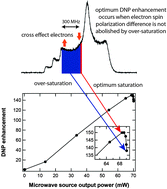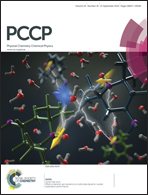Effect of electron spin dynamics on solid-state dynamic nuclear polarization performance†
Abstract
For the broadest dissemination of solid-state dynamic nuclear polarization (ssDNP) enhanced NMR as a material characterization tool, the ability to employ generic mono-nitroxide radicals as spin probes is critical. A better understanding of the factors contributing to ssDNP efficiency is needed to rationally optimize the experimental condition for the practically accessible spin probes at hand. This study seeks to advance the mechanistic understanding of ssDNP by examining the effect of electron spin dynamics on ssDNP performance at liquid helium temperatures (4–40 K). The key observation is that bi-radicals and mono-radicals can generate comparable nuclear spin polarization at 4 K and 7 T, which is in contrast to the observation for ssDNP at liquid nitrogen temperatures (80–150 K) that finds bi-radicals to clearly outperform mono-radicals. To rationalize this observation, we analyze the change in the DNP-induced nuclear spin polarization (Pn) and the characteristic ssDNP signal buildup time as a function of electron spin relaxation rates that are modulated by the mono- and bi-radical spin concentration. Changes in Pn are consistent with a systematic variation in the product of the electron spin–lattice relaxation time and the electron spin flip-flop rate that constitutes an integral saturation factor of an inhomogeneously broadened EPR spectrum. We show that the comparable Pn achieved with both radical species can be reconciled with a comparable integral EPR saturation factor. Surprisingly, the largest Pn is observed at an intermediate spin concentration for both mono- and bi-radicals. At the highest radical concentration, the stronger inter-electron spin dipolar coupling favors ssDNP, while oversaturation diminishes Pn, as experimentally verified by the observation of a maximum Pn at an intermediate, not the maximum, microwave (μw) power. At the maximum μw power, oversaturation reduces the electron spin population differential that must be upheld between electron spins that span a frequency difference matching the 1H NMR frequency—characteristic of the cross effect DNP. This new mechanistic insight allows us to rationalize experimental conditions where generic mono-nitroxide probes can offer competitive ssDNP performance to that of custom designed bi-radicals, and thus helps to vastly expand the application scope of ssDNP for the study of functional materials and solids.


 Please wait while we load your content...
Please wait while we load your content...